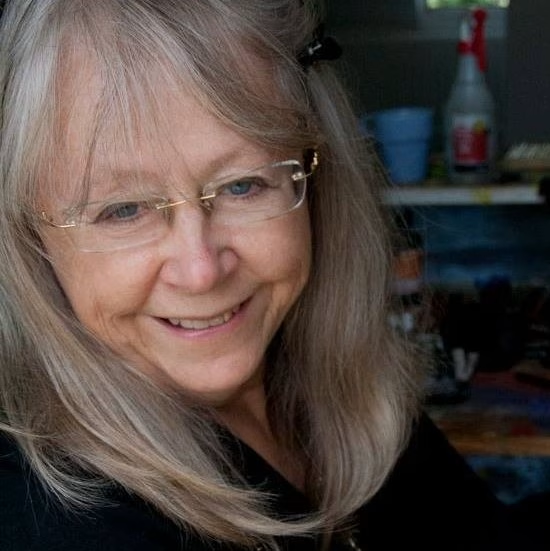The latest interview in the Ole Miss Retirees features Dr. Paula Temple. The organization’s mission is to enable all of the university’s faculty and staff retirees to maintain and promote a close association with the university. It is the goal of the Ole Miss Faculty/Staff Retirees Association to maintain communication by providing opportunities to attend and participate in events and presentations.
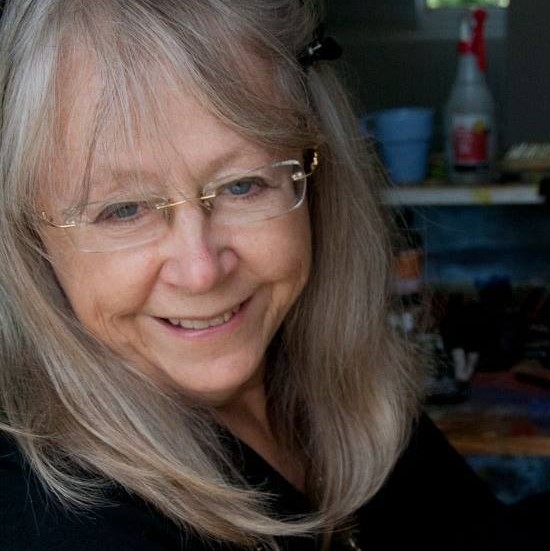
Temple, a talented artist and Tennessee native, brought her passion for art to Ole Miss following 12 years of work as an illustrator, exhibiting artist, graphic designer, and through a Peace Corps Contract in the Eastern Caribbean. She now enjoys life in France pursuing her art.
Brown: Where did you grow up? What was special about your community?
Temple: Memphis, Tennessee. I had a typical southern home on a dead-end street near the University of Memphis. A mother who stayed home, made all our clothes and created a comfortable home. My father had the Easy Method Driving School and later on worked at various other jobs. We went to church every Sunday and I had babysitting jobs in the neighborhood. We had the Mason YMCA near our house that my younger sister and I attended regularly.
I thought there was nothing remarkable about my hometown until I began to travel in my twenties. When I told people I was from Memphis, Tennessee, most thought that was fabulous! It was because of the reputation of the musicians that come from this city.
Brown: Talk about your parents and any siblings.
Temple: Both of my parents, Albert Turrentine Temple and Pauline Lawell, are from Bedford County, Tennessee, from the small towns of Halls Mills and Shelbyville. Most of my family were farmers and some were involved with The Tennessee Walking Horse National Competition, sometimes known as the Celebration, which is the largest horse show for the Tennessee Walking Horse. During WWII, my parents worked for the Martin Plant in Baltimore, Maryland, building the Martin Marauder airplanes. I was born there and shortly afterward they returned to Tennessee. I have one younger sister, Margaret Ann Temple, who is an architect in Chicago, Illinois.
Brown: Describe your childhood.
Temple: I had an average childhood in the 1950’s and 60’s, biking with friends, playing hide and seek, jumping rope in the street, playing jacks on the porches, enjoying treats from ice cream trucks, roller skating and much more with the kids in the neighborhood.
Brown: What is your favorite childhood memory?
Temple: Spending summers with my grandparents, aunts and uncles and cousins in Shelbyville, Tennessee on farms with horses, cows, gardens, barns and a town with a square like Oxford. My cousins and I collected blackberries and our grandmother made the best cobbler you ever tasted.
Brown: What were you really into when you were a kid?
Temple: The Mason YMCA near our house had a pool and a gymnasium and a game room. This was my home after school. I loved to swim, play basketball, gymnastics and play pool. I was on the swimming and diving team, the basketball team and the gymnastics team. None of these things were available to me at school. I also became very interested in the Olympic Games, not only the sport but also the people from different countries. I was very fascinated with the world. I loved staring at the world maps and globes in the classrooms.
Brown: Where did you go to school?
Temple: I went to kindergarten at Buntyn Presbyterian, grades 1-8 at Memphis State Training School on the campus of University of Memphis and grades 9-12 at Messick High School.
Brown: What was your high school experience like? Were you a good student? What was your favorite subject? Least favorite subject?
Temple: Frankly, I was very bored in high school. After coming from the exciting experience of the Campus school, the instruction seemed too slow, too generalized and I was a good student. I took the language courses, Spanish and French, and the art classes along with the regular curriculum. I was also very interested in the history and geography classes; actually, anything to do with travel. My least favorite was math.
Brown: You received your BFA from the University of Memphis and your MFA from the University of Tennessee. Talk about your college experience.
Temple: I was the first in my family to go to college. It was a huge responsibility. I worked 2-4 jobs at a time to continue my studies in college. I applied for the very few scholarships available one was the Tennessee state scholarship. If your GPA scores were maintained at a certain level, they paid the tuition. I still was interested in languages and art and travel. I took Italian classes. The degrees I earned were in studio art, Printmaking and Painting.
I earned the fine arts degrees but there was no travel abroad study classes at that time. I excelled in the studio classes and was encouraged by the good grades, however most of the professors did not think women could be successful artists. The entire studio faculty was men and full-time job opportunities in this field went to men with families to support. I didn’t let this discourage me, but it remained a problem.
Brown: What was your first job, perhaps as a teenager? What was your pay and what were your responsibilities?
Temple: At the YMCA in my neighborhood, I was a lifeguard, a swimming instructor, an assistant in the art classes, helped teach the gymnastic classes and manage the gymnasium equipment. I was paid with a yearly membership at the YMCA, $12.00 a year.
Brown: Describe your young adult self.
Temple: I was always yearning to travel. I remembered the global maps on the schoolroom walls. The Peace Corps Program starting up in the 1960’s inspired me. The art history courses and language classes I took inspired me. This became a goal of mine, to travel.
Brown: Talk about your path to Ole Miss. What other jobs did you have?
Temple: Since graduate school, I had a number of part-time, temporary teaching jobs teaching art, exhibiting in galleries and art services for design companies. These were at the College of Charleston and the High School of Charleston in Charleston, South Carolina; Santa Rosa Community College in Santa Rosa, California; illustrator at Santa Rosa City Printer in Santa Rosa, California; handicraft designer at the Ministry of Culture in St. Georges in Grenada and Castries, St. Lucia, West Indies (Peace Corps Contract); art services and rendering artist at Carol Korn Design in Miami, Florida; and Roberson Ward Architects in Castries, St. Lucia. I was also an exhibiting artist in Grenada, West Indies; in Napa and Santa Rosa, California; and in Charleston, South Carolina.
Brown: Tell us how/when your Ole Miss “story” began. Tell us about the interview process. Who hired you? How long did you work at Ole Miss?
Temple: I was in Miami at my job at the Design firm when I got a call from my friend from graduate school, Jere Allen, who I hadn’t seen in years. He asked me what I was doing and then asked me if I would apply for a job in the Department of Art at the University of Mississippi. I remember asking him if it was a full-time, tenure track position because I had had enough of part time work. He said it was, so I applied. I came to the campus in July 1985 and did a presentation and interview with the faculty in the Art Department, the Graduate School, and the Liberal Arts Office. I was staying in the Ole Miss hotel on campus. Margaret Gorove, chair of the art department, came over to take me to a dinner and said, “Congratulations, we have voted, and you are the first full-time female Professor of Studio Art hired at Ole Miss.” That was a good day for my family and me. I retired after 30 eventful years.
Brown: What were your job responsibilities?
Temple: My job responsibilities were teaching three studio classes per semester; most were stacked classes. Managing the Visual Communications Department (later changed to Graphic Design). Working with undergraduate students as well as graduate students. Maintaining my professional practice in studio art. Service to the Department and the Liberal Arts Office and to the University committees. I also initiated a study abroad program.
Brown: What did you know about Ole Miss before you accepted a position here?
Temple: My first time on the campus of Ole Miss was taking my little sister to Cheerleading Camp. I explored the campus and the Art Department at that time. I was then a student at Memphis State University. I knew it had a lovely campus with a small art department. I knew it was known for William Faulkner and James Meredith.
Brown: Everyone has that most “memorable” day at work whether it was really good or really bad. What day was that for you?
Temple: I remember driving to campus with my sack lunch, parking and going into the Old Chemistry building to go to my office. As I got out of my car a policewoman rushed up to me and screamed “Help me, I’ve been shot!” I then heard gunshots and knocked her to the ground and covered her. The shots stopped and I saw something out of the corner of my eye happening to the shooter. I then got her up and got her into the door of the building cried for help and Dr. Tom Dewey came from his classroom and a graduate student who ran and got a blanket helped me. The ambulance came, everyone left, and I just sat there on the stairs and ate my lunch.
Brown: What advice would you give to your 20-year-old self?
Temple: Be more confident and independent. Don’t believe everything you have been told. Do your research and find things out for yourself. Learn to trust your instincts.
Brown: What makes you angry?
Temple: Unequal opportunities and pay for women.
During my career as a professor in the Department of Art, I never had an assistant. I often asked for a graduate assistant to help with my classes and other projects. Other professors had several, but I was never given any graduate assistants.
Regarding retirement, I enjoyed my career at Ole Miss and after 30 years it was time to move on and continue my studio practice. I have always thought I would be a part of the University family after retirement. I am a member of the Association of Americans Residing Overseas (AARO) and very helpful organizations. I have visited the universities in Paris where we have exchange programs and made myself available if necessary. I was a little surprised to learn about the phrase “separated from the University” during retirement meetings. I have never felt separated.
Brown: You have received many awards including a national competition sponsored by the American Cancer Society; you were the recipient in 2000 of the Mississippi Institute of Arts and Letters: Visual Arts Award. In addition, you are a three-time recipient of the Mississippi Arts Commission’s Individual Artists Fellowship. Tell us about these awards and what they meant to you.
Temple: It is always good to get recognition for your work. An award always boosts artists. We also consider opportunities to exhibit our work as an award. In 2010, I received an Honored Artist Award from the Mississippi Chapter of National Museum for Women in the Arts in Washington, DC. The Director, Susan Fisher-Sterling presented this award to me at the Jackson Country Club in Jackson, Mississippi. I live in France now and in 2017, I went to a forum on Women Artists in Paris at the Mona Bismarck American Center for Art and Culture. Susan Fisher-Sterling was on the panel. After the presentations, I talked to her, and it was a good meeting. I didn’t know it at the time but Rebecca Dolinsky, who heads up a women’s artist salon in Paris, was listening and invited me to join the Salon for Women Artists in Paris. Every Thursday at a café in Paris I meet with women artists who live in Paris but are from everywhere. This has led to some opportunities for my work as well great friendships.
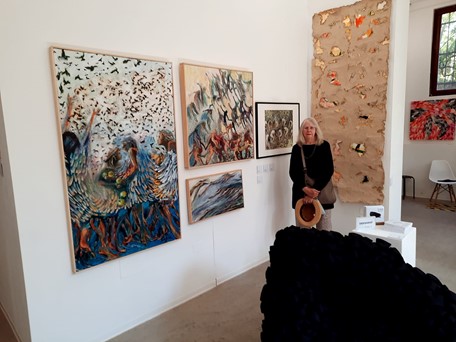
Brown: I know you mentioned having taken foreign languages. Are you fluent in French?
Temple: No, I manage pretty well, but I still make mistakes. Immersing myself in French in my 60’s and 70’s has not been easy; however, I learn more and more every day. I love France and I have discovered France loves artists.
Brown: Did you have a mentor that influenced your career path?
Temple: I have tried to define a mentor, but I can’t think of anyone who encouraged me or has shown me the path. I have had some good teachers but none that would consider me seriously. People who have hired me or given me awards or commissions and had exhibitions of my work have always been appreciated.
Brown: Tell us about your husband. How did you meet? How long have you been married?
Temple: Peter Adrian Baron-Robbins is my husband, whom I met while living in Saint Lucia West Indies. He is a citizen of the United Kingdom. We were married there in 1982.
Brown: You mentioned your daughter is also an artist. Talk about her.
Temple: My daughter is Ariel Baron-Robbins. She graduated from the University of Mississippi in 2005 with a BFA degree in art and has an MFA degree from the University of South Florida in Tampa with emphasis in painting. She lives in Miami, Florida, and teaches studio art and art history courses at Broward County Community College and Miami Dade Community College. She is also an active painter and works in video and photography.
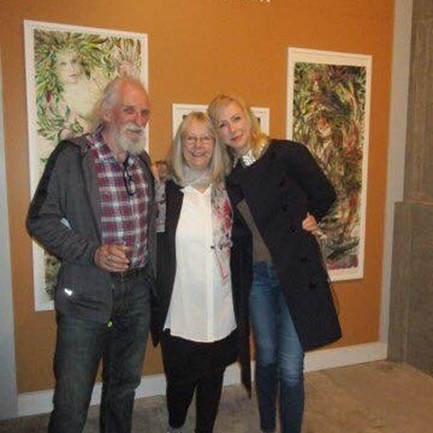
Brown: You create beautiful art. Is there a single piece that is your favorite? If so, why is it your favorite?
Temple: I like to consider my latest painting my best painting. I have some favorite pieces from different periods of my work. Muwork is grouped in The Window Series, The Black Bird series, the Greek Myth influenced series, The Nature Series, The Gatherer Figurative series involving grouped figurative images based on abstract compositions. I brought my entire studio from Oxford to Marnay-sur-Seine. I have many sketchbooks and drawings that I continue to reference for my paintings. One thing I have done recently is rework older pieces. I sand and scrape out areas, which never were quite well resolved and repaint the areas. This has been an interesting process working on a painting I did years ago and reliving it in the present. There are a lot of theories about the high points and low points in an artist’s lifetime of work. As a younger artist, I worked very quickly through ideas and as an older artist I am much more contemplative about my painting. I slow down and rethink about what I am doing.
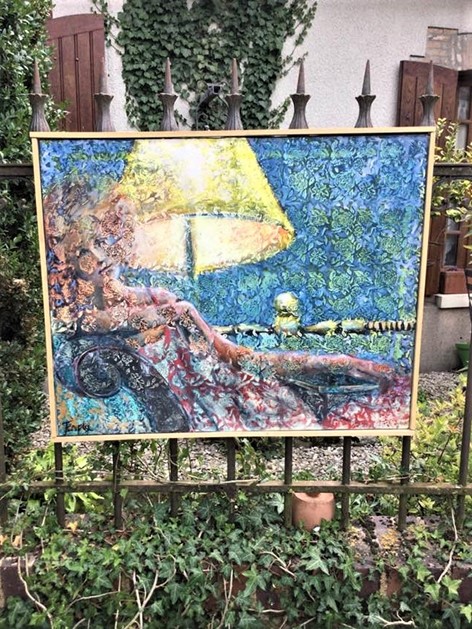
The layering of new ideas and better skills on the older, playful images is a revelation. Some favorites are, a large triptych piece called Rapping at My Window, Tapping at My Window Saying Let Me Come In. This is a three-part, (triptych) oil on canvas first exhibited in the University Museums around 1991. It was a precursor to the piece Light, Grace, and Spirit I did for the American Cancer Society. Fortuna, I did for a Salonista project (my Paris salon group). It is about the goddess of fortune spinning her wheel as many fall off. I think it may be on my website. Cissos is also a painting from my Greek legend series. The Bird Watchers, The Storks Nest (La Nid de la Cigoyne), and Red Handed Greeting are very recent paintings from the Figurative and Nature series, are among favorites. Some of these are on my website, www.paulatempleart.com.
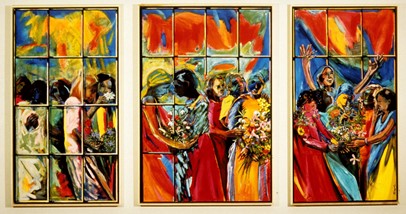
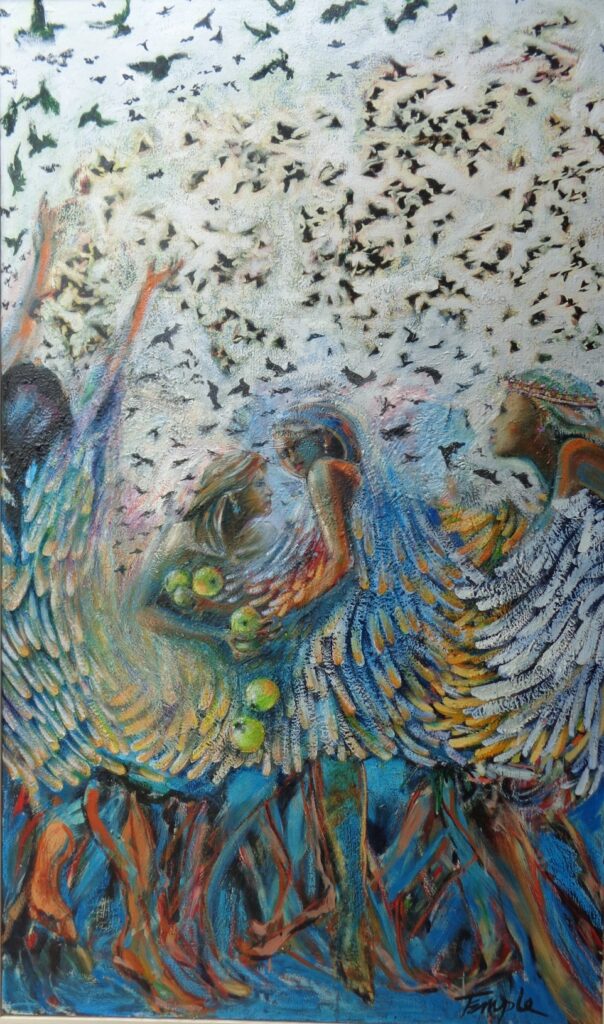
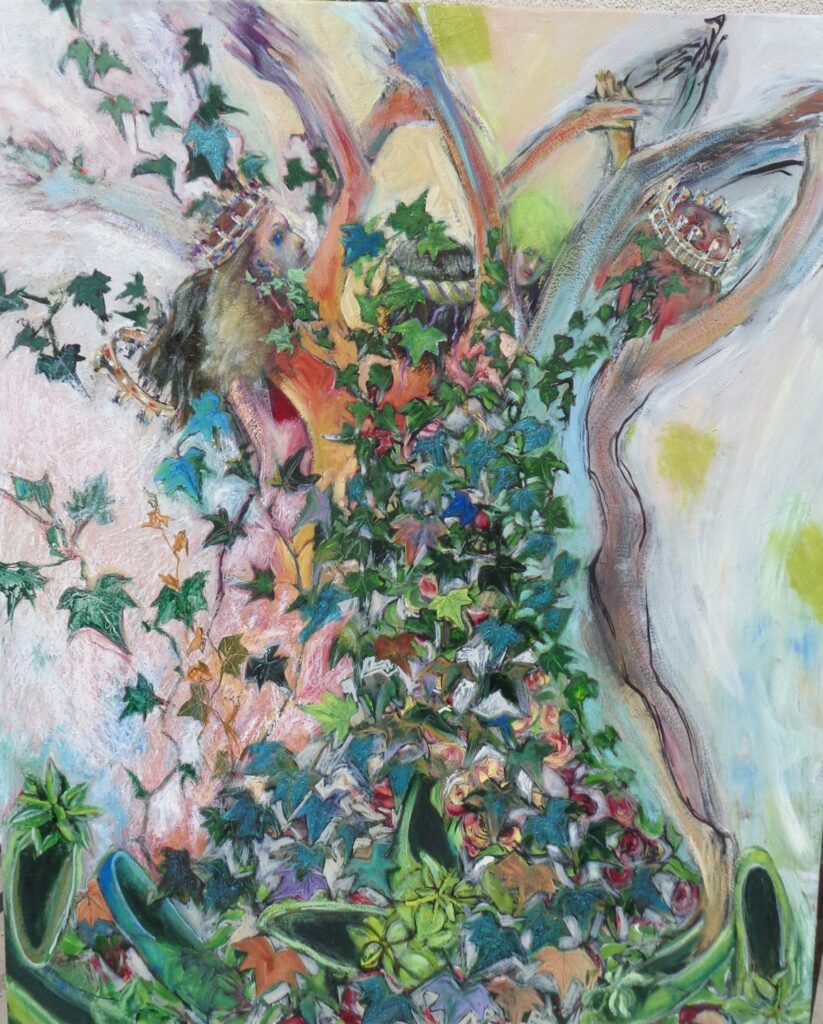
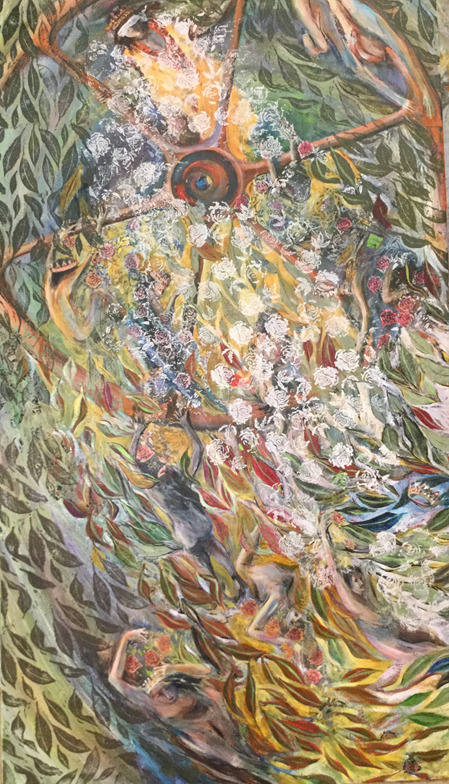
Brown: Tell us about some of your favorite piece/painting/drawing done by other artists.
Temple: Every time I see a good show I have new favorites. I have a method of viewing a large museum. I enter the museum and walk through the many rooms of work. I will pause in each room, scan the walls and stop to look at only one or two pieces that instantly spoke to me. Therefore, these artists communicated something to me that simply says stop and watch me, let’s have a conversation. After I view the museums this way, I have a cup of coffee and return to the same rooms and see if the same works attract my attention, or new ones took their place. This is an interesting exercise that I taught my students in my study abroad classes when we visited a large, important, art museum. It also promoted very good discussions.
A favorite artist of mine is Roberto Matta. I admire his ability to compose as well as incorporating in-focus and out-of-focus areas of painted images.
Brown: Tell us something about yourself that many people may not know.
Temple: A life-changing event that took place in 1976 was my trip to Europe. Four years after I finished my degrees, I packed a small backpack, a Eurail card, a Youth Hostel Card, and very little money and took off to visit all the major art museums and areas of interest to me as an artist. I spent about five months traveling alone meeting some very interesting people and visiting some incredible museums. I saw artworks I studied in books and on slides. I saw artists and artworks I didn’t know existed. Every day was a revelation. Shortly after returning to part-time work in California, I joined the Peace Corps and left for the West Indies on another adventure.
Brown: Whom would you want to play you in a movie of your life?
Temple: I think a great series or movie could be made about my Salonistas group in Paris. This is a group of women artists who meet every Thursday in Paris and talk about art. There are musicians, painters, sculptors, photographers, writers etc. I was invited to join them in 2017. The individuals in this group are from all over and all have interesting stories. My part could be played by, Glenn Close, Candice Bergen or Meryl Streep.
Brown: You have spent a great deal of time in France. Do you still maintain a painting studio in Marnay-sur-Seine, an hour from Paris? Tell us what attracted you to France?
Temple: I came here in July of 2013 to work in an artist’s residency. While sitting in my office at Ole Miss, I received an email from ArtistStay.org about applying for artist’s residencies in France. I have never been to an artist’s residency and wanted to know more. I was asked to send a link to my website. They would view the work and then asked me to send a statement of proposal of work I would do in a residency. I sent this as well, and then they asked me to send a resume and time available. I was then offered two residencies to choose from. I chose the one in Marnay. I loved the experience; I had a beautiful studio overlooking the River Seine and met fellow artists from all over. They had eight artists a month in this residency. I continued to return to Marnay two more times at the artist residency. On the second occasion I was walking down the street with a friend and a man walked out of his house and asked us to look at his house. We just had been to a neighbor’s house that was for sale, and I had been looking for something to rent. My friend knew this man and we went in. He wanted me to buy his house. He showed me around and it was wonderful. Two old stone houses that had been joined together with a large garden and a garage with a large room on top. He asked me what I would do with it, and I said I would make a painting studio. I retired in 2014, sold my large country house in Oxford and here I am.
Having a painting studio in a small village in France only an hour away from Paris has been an ideal retirement for me. We have two artists’ residencies here that host artists from all over the world. I am very grateful to the University of Mississippi Department of Art for granting me the position as professor that allowed me to discover a range of possibilities offered to art professors. We have had several professors and musician friends from Ole Miss visit and work in our residencies. Ann Fisher-Wirth, Ginny and Ashley Chavis, Robert Riggs, Damien Wash, Amy and Luke Fisher, Milly West, and more have been here.
I have a Galerie du Trottoir (Sidewalk Gallery) that opens on weekends during Covid-19 lockdowns. Every weekend I hang works of art on my ornate iron fence in front of my house. My artist friends in Paris were putting work on their balconies and I had no balcony, but I have a fence. Jennifer Sickling’s article titled Fenced Art, in Our Tennessee, an online newsletter from my alma mater, the University of Tennessee, Knoxville, recently featured this project in an article.
Brown: If you could choose one age to be forever, what age would it be and why?
Temple: 40-45, this seems to be the age I most was active and productive. I also like the physical strength I had at this time. I do think artists continue to get better and better as they age. Many critics and art historians believe that the late work of an artist is not as good as mid career. I disagree. When I view an artist’s retrospectives, I see the depth of understanding in the later pieces. It is a real shame when artists die young.
Brown: What is your proudest accomplishment?
Temple: Good painting. I do good paintings. People asked me what am I trying to do? And I answer a good painting. It is very difficult to do a really good painting. It is very easy to continue doing a popular painting over and over again in order to be consistent and assure sales. Galleries and critics love this. When good ideas continue to come, I work them out in my paintings. I don’t let them fade for the sake of consistency. Consistency is there if you are experienced and wise enough to see it.
Brown: To what do you attribute the biggest successes in your life?
Temple: I have perseverance in my goals despite many obstacles in my way. I have seen so many quit because of something someone has said and done to them. Luck has been good to me at times. Being in the right place at the right time. But most of all I believe in my work. I do good work and it is successful. How do you measure success? Awards won? Sales records? Recognition? Some day I may be more recognized than now. I am concerned about what happens to the work if not sold or collected.
Brown: What activities cause you to feel like you are living life to the fullest?
Temple: Going to work in my studio everyday. Assisting with artists in our artist residencies. Swimming the currents of the Seine in the summer. Seeing my daughter who is also a wonderful artist. Staying as healthy as possible. Working in my garden. Visiting art museums and collections. Meeting with my art salon each week.
Brown: What five words would your friends use to describe you?
Temple: Tolerant, dependable, generous, kind, intelligent.
Brown: What’s the best part of your day?
Temple: Working in my studio.
Brown: What habit do you have now that you wish you started much earlier?
Temple: Documenting my work. I have lost a lot of work along the way, some lost, stolen, sold and not recorded.
Brown: What life skills are rarely taught but extremely useful?
Temple: Learning how to control your finances. Learning how to be more self-confident Learning other languages Learning how to be independent. Learning how to trust your instincts.
Brown: What do you do to get rid of stress?
Temple: Swim in the currents of the river. Go see a good museum.
Brown: What’s the most useful thing you own?
Temple: My home, my studio.
Brown: What is your guilty pleasure?
Temple: Traveling alone.
Brown: What causes you to lose track of time?
Temple: Working in my studio.
Brown: Where is the most awe-inspiring/interesting place you have been?
Temple: Encounters with the underwater world while scuba diving in the Grenadines. Great cathedrals, Notre Dame in Paris, La Sagrada Familia, Gaudi cathedral in Barcelona, The Alhambra, in Grenada, Spain, the art museums of the United States and Europe.
Brown: What’s left on your bucket list?
Temple: To have a retrospective exhibition of my work at a good museum. Learning how to speak other languages fluently.
Brown: To quote Katherine Meadowcroft, cultural activist, and writer, “What one leaves behind is the quality of one’s life, the summation of the choices and actions one makes in this life, our spiritual and moral values.” What is your legacy?
Temple: I have created a lot of paintings, drawings and artwork of various media for others to enjoy. I hope that my body of work will be preserved by someone, somehow. Others have come to me and said, “I remember a painting you had in a show,” and they describe it perfectly. This memory of an artwork meant that it truly communicated on a visual level. Some of the best memories I have of teaching are when former students contact me and say, “I remember when you told me ‘Do what you are sure of first, then reconsider the what if’s,’ or ‘Don’t measure your worth by what others say.’ ” I keep in touch with a lot of my former students.
Bonnie Brown is a retired staff member of the University of Mississippi. She most recently served as Mentoring Coordinator for the Ole Miss Women’s Council for Philanthropy. For questions or comments, email her at bbrown@olemiss.edu.
